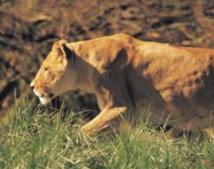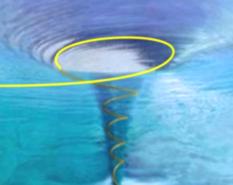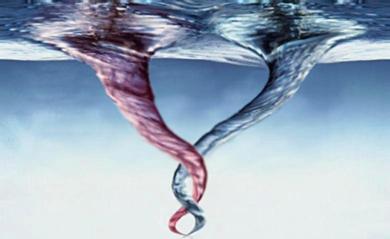
How Does SE® Work?
Somatic Experiencing® was developed by Dr. Peter Levine following his observation that animals in the wild do not get traumatized even though daily they are faced with life threatening situations. Dr. Levine observed the mechanisms by which animals are able to shake off the high levels of nervous system arousal and return to their daily lives. He then began to ask the question of why humans are so susceptible to the devastating effects of trauma.
What he realized is that as the neocortex evolved, that part of the brain that makes us the most human, giving us the ability to think and ponder deep philosophical questions, our ability to override our instinctual responses also came online. Now, in most cases this is a really good thing. We don't have to automatically lash out and kill someone just because they took our food. We can creatively think up better strategies to deal with threats. But, as with most things in nature, being given a new and enhanced capability usually involves losing some part of an old one in its place. In this case the ability to override the instinctual responses of the nervous system left us with a vulnerability to being traumatized.
First, let's look at some of the underlying theory on which SE® is built. We start with the Polyvagal Theory of Dr. Stephen Porges at the University of Illinois. Physiologists and medical schools are still teaching (incorrectly) that the ANS exists in two states (or phases): fight or flight (sympathetic) and rest and recuperation (parasympathetic). Dr. Porges observed that we actually have three states in the ANS which form a heirarchy. He calls these states 'Social Engagement' which is parasympathetic, 'Fight or Flight' which is sympathetic, and 'Freeze' which is parasympathetic and sympathetic activation simultaneously. Let's look at how this works in other mammals and see why these states have evolved.

Take for instance an impala grazing on the savannah in Africa. The impala will be calm and relaxed as it grazes with other impalas in its herd. It will be alert and will be orienting to the environment around it to assess for potential danger through its senses of sight, smell, and hearing. The other impalas are doing the same, orienting to possible danger and orienting to each other for signs that they spot danger. If they see a dangerous situation they will alert the herd to it.

This social cooperation and awareness of each other gives many more danger sensors than a single individual impala has in his own body. This state is what Dr. Porges calls social engagement, and it is the newest ANS state to evolve. Through this herd behavior the pack animals are able to work together watching out for each other's survival.
When the impala hears a twig snap it alerts to the sound, it scans the horizon to locate the potential danger. Seeing none it goes back to grazing. One day the snap alerts the impala to a lioness on the savannah.

The impala gets a jolt of adrenaline. Its nerves become activated with electric charge. Its muscles tense. Blood begins to shift from its abdominal organs and its periphery to its large muscles to prepare it for flight. The lioness is still far enough away as to not pose immediate danger so the impala continues to track the lioness with his senses.
At a certain point the lioness goes away. The impala now has to deal with all of the energy that has built up in its system that is no longer needed to flee from the lioness. It does this by a rhythmic shaking in waves of muscular discharge. The flight energy is dissipated and the impala goes back to grazing.
In another scenario the lioness crosses an imaginary line that is close enough for it to be a threat to the impala. The impala takes off running to escape the hungry lioness. He is now actively in fight or flight. His behavior is flight. His nervous system state is fight or flight. The charge that had built up in the impala is coming in useful at this point, this is life or death. As the lioness closes in on the impala and is just about to grab the impala in its powerful jaws something odd happens. The impala collapses and can no longer run, can no longer even move. The lioness pounces and grabs the impala in its jaws. What just happened?
The impala went into freeze. In humans full-on freeze is called fainting. Technically, freeze is called the 'dorsal vagal reflex.' How does freeze serve the impala? To the lioness freeze looks like death. So, the lioness doesn't have to break the impala's neck because it already appears dead. Because the impala is paralyzed in freeze it can't even lick its wounds, a behavior that would signal the lioness that the impala was still alive. Also, to keep the impala from screaming in pain if it sustained bites, nature assured that in freeze the impala is disconnected from pain by causing dissociation in the brain. With a heavy shot of endorphins, those heroin like chemicals in the brain, and some rewiring of the brains switchboard, the brain literally disconnects the sensory centers from the feeling centers and the rest of the brain.
The lioness has just run a strenuous race itself and if she laid down right then and there to devour her prey the lioness would be vulnerable to hyenas or other second string predators stealing her meal (see Freeze video). So, the lioness drags the impala back to her lair while catching her breath. Maybe the lioness goes to round up her cubs for dinner. During this time the impala comes out of its freeze state and runs away. So, what we see here is one more mechanism that evolution has devised to assure survival. Pretty ingenious, no?
In the human nervous system we still have freeze as an algorithm that can be run to protect us. But, in humans it is a bit more complicated. In most cases we can at least partially override freeze. Most people have never fully fainted in fear. But, most of us have temporarily been unable to move, or have spaced out, or went speechless in fear. Many of us have experienced slo-mo consciousness just before impact in an automobile accident. Some people who have had a near death experience have reported 'going out of their body' when in great pain or fear. In this last case they may report hearing a scream coming from over there, and then realize that that is their own body over there doing the screaming. These are all aspects of freeze/dissociation.
We have several synonyms for freeze, including dissociation, immobility, spacing out, deer in the headlights look. In the healthy nervous system it still serves and protects us humans, but often freeze is associated with the residual crippling effects of trauma. Here's what happens that causes humans to get stuck in trauma. When we are faced with a life threatening crisis our nervous system develops a motor plan for escaping it. Usually that motor plan begins to be executed, for example running from a predator. But, when that plan is thwarted by being caught by the predator, or running out of oxygen, or finding ourselves cornered in a dead end situation, we go into freeze.
Even though we cannot escape, our protective motor plan continues to go around in our brain. Remember in the animals when they come out of freeze the energy is drained off by running to escape or by the rhythmic waves of muscle contractions. This doesn't happen in humans every time, or we override the trembling that would help accomplish this. So, we are left highly activated with an incomplete motor plan still going round and round in our brain. This motor plan wants to complete and so our unconscious mind may continually place us in situations similar to this one so that we can use the motor plan to complete the movement back to safety. Freud called this a 'repetition compulsion.' But, rarely is the new situation enough like the old one that the same motor plan can resolve it. Thus, we tend to accumulate more and more traumas which are sort of similar to the original. Have you ever known someone who is 'accident prone,' or who keeps having similar sorts of accidents or assaults? This is what's happening in them.
These incomplete motor plans continue to run long after the original event. They waste mental energy and they continually activate the nervous system towards fight or flight or even push it into freeze with the right kind of threat. You may have observed people that are always hyper, or hypervigilant. They look like they have had too much coffee. Those are people who have gotten stuck in the sympathetic system activation of fight or flight. You may have also observed people that always look spacey or confused. Those are people who are caught in some degree of freeze.
Most of us in this technological age have experienced our computers slowing to a crawl when some error causes a program to get stuck in a continuous loop, eating up CPU cycles. We sit there waiting and waiting for the task at hand to complete. Finally, in exasperation we reboot the computer and things go back to normal. When the brain is stuck with several of these protective motor plans running all the time because they can't complete, our brains run slow and inefficiently, just as our computer does.
In Somatic Experiencing® what we do is work to resolve the incomplete motor plans and to facilitate a resilient moving of the ANS from state to state, rather than becoming fixated in one state. When these old motor plans are allowed to complete in the SE® process the nervous system can return to processing the task at hand rather than burning up brain power defending against a threat that is no longer there. This is just like rebooting your computer to get it back up to speed on the task you want to work on.
The next part of SE® theory that we want to look at is called the 'vortex system.' Dr. Levine observed that when trauma strikes it is like a meteorite falls from space and has a huge impact on the earth below. In this metaphor, there you are gently rafting down the river of life and a huge meteoric trauma impacts just outside of the containing boundaries of your river of life. This creates a deep hole and the water rushes from the river into this hole. Like water going down a drain it creates a spinning vortex that spins faster and faster and becomes more and more inescapable as you go down the hole.

This vortex, like a tornado draws you in and sucks you down if you get near to it. This is very much what it is like for people who have unresolved trauma. Anytime they get into a situation that closely resembles the trauma event they are in extreme danger of being sucked down into this trauma vortex. The closer they get the more the draw. It is scary, it is painful, and it feels life threatening getting sucked in and not being able to stop.

As we go through life we tend to accumulate more and more of these unresolved trauma vortices. People will go way out of their way to avoid the life threatening danger as they make their way down this stretch of their river of life again. They develop avoidance behaviors and even phobias in order to stay away from the threat, which is really just a physiological memory of a threat. In so doing their world becomes smaller and smaller. One day they may wake up with agoraphobia, the fear of going outside, along with an accompanying panic disorder. Or they may, as stated earlier, develop a repetition compulsion and keep being drawn to and even seeking out behaviors that will end up with them going down the vortex. Going down a trauma vortex will take you from social engagement to fight or flight on the way down, as you panic to save yourself, to freeze when your body realizes that you are stuck and nothing you do can rescue you now from this vortex's draw.
In working with trauma victims Dr. Levine observed that whenever they began to recite the story of what happened to them, along with the account of danger and panic there was always something pleasurable and life affirming that seemed to be in proximity to the threat. For instance a shark attack victim may be talking about seeing the shark coming and how big its teeth were. And, in the next thought he may say, "But at the same time I was noticing how crisp and cool the water was that day and it really felt refreshing." Or, someone emerging from a near death experience will declare in wonder, "I'm alive!" The two always seem to occur together.
So, the other half of the vortex theory is that when a trauma vortex is created, simultaneously an equal and opposite countervortex forms in the river. This would not be surprising to a river rafter. Rafters are used to dealing with eddy currents where water flowing downriver can actually turn and go back upriver as it passes obstacles. In our trauma model two vortices are formed, one of which is life threatening and feels terrible so we denote it as the 'Red Vortex' to denote danger, and the other of which is life affirming and feels pleasurable, so we denote this one as the 'Blue Vortex.' We will use this in a very clever way as you will see below in order to heal from the trauma that created these vortices in the first place.

The trauma vortex represents the activation of the sympathetic nervous system and the countervortex represents the soothing, healing thought or feeling which allows the nervous system to return to the homeostasis of social engagement. Just as a mountain climber uses ropes anchored to the mountain to keep from falling down the cliff, we who have training in Somatic Experiencing use the draw of this pleasurable countervortex to anchor the client so they don't fall down the trauma vortex every time they get near to it. We will spend some time together experiencing the pleasurable, life affirming sensations and feelings, then let the system swing over to the draw of the life threatening situation, but then use the pull of the life affirming to draw back from the danger zone. This swinging back and forth is like the motion of a pendulum, so naturally Dr. Levine called it 'pendulation.'

This is one of the key reasons we can revisit traumatic events without retraumatizing the client. Because we work in small 'titrated' doses of danger that are manageable and not overly threatening to the client, but always using the draw of the pleasurable life affirming countervortex to pull us back to safety.
With each pendulation we make around these two vortices some of the energy of each vortex is drawn off and the depth of the vortex is decreased. After sufficient pendulations the energy of the vortices are sufficiently removed as to become non-existent and our client can now travel this part of his river of life with no reactivation and no panic. It is now safe.

In the next section we will take a look at what a typical SE® session looks like.
| Prev. | 2 | Next |
